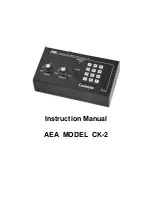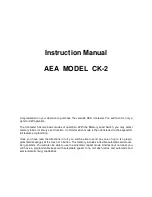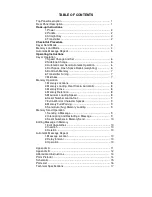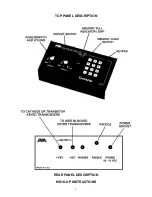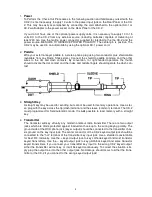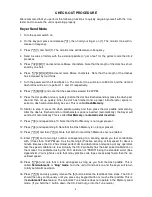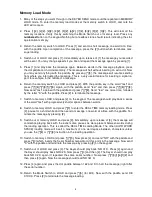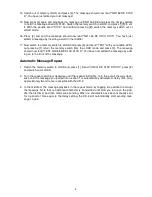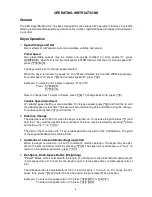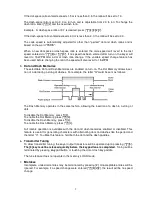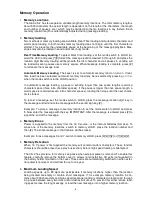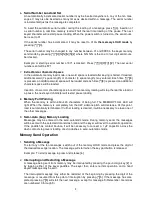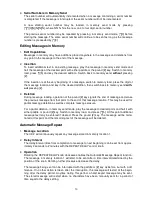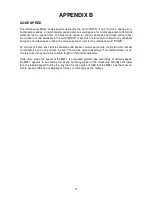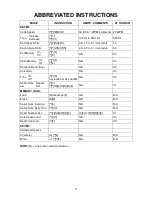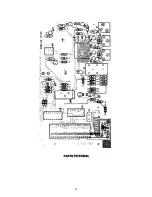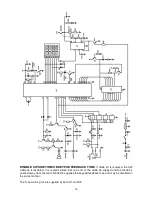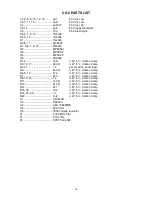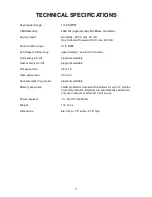
3
CHECK-OUT PROCEDURE
We recommend that you perform the following functions to quickly acquaint yourself with the Con-
tester and to ensure the unit is operating properly.
Keyer Send Mode
1. Turn the power switch on.
2. On the keypad, press and release [
*
][1], then hold your finger on [1]. The monitor tone will in-
crease in frequency.
3. Press [
*
][
*
][1] and hold [1]. The monitor tone will decrease in frequency.
4. Send a series of letters with the external paddle to "get a feel" for the perfect code the CK-2
produces.
5. Press [
*
][2][0][#][7] and send more Morse characters. Note that the length of the dots has short-
ened by one half.
6. Press [
*
][
*
][2][2][4][#][0]and send more Morse characters. Note that the length of the dashes
has increased by four-thirds.
7. Turn the power switch off and back on. The monitor tone will return to 500 Hz and the dot and
dash ratios will return to perfect 1:1 and 3:1 respectively.
8. Press [
*
][
*
][8][0][2] and note that the speed has slowed to 2 WPM.
9. Press the dot paddle and very quickly (before the dot has finished sending) press the dash pad-
dle and then let up quickly. After the dot has finished and a proper intracharacter space in-
serted, a dash will automatically be sent. This is called
Dash Memory
.
10. Similar to step 9, press the dash paddle quickly and then press the dot paddle momentarily.
After the dash is finished and an intracharacter space is inserted (automatically), the Keyer will
send a dot automatically This is called
Dot Memory
or
automatic dot insertion
.
11. Press [
*
][3] and repeat step 10. Note that the Dot Memory is no longer present.
12. Press [
*
][4] and repeat step 9. Note that the Dash Memory is no longer present.
13. Press [
*
][
*
][3] and then [
*
][
*
][4]. Note that both Dot and Dash Memories are re-enabled.
14. Enter [
*
][
*
][8] and a two digit number corresponding to a sending speed you feel comfortable
with. (If less than 10 WPM use 0 as the first digit.) Practice sending at that speed for about a
minute. Because the CK-2 has almost perfect dot and dash ratios and spacing, many operators
feel the speed calibration is low. Actually the CK-2 probably has the best speed calibration on
the market. It is calibrated using the FCC definition of "PARIS" being the standard word. (See
Appendix B.) You might also note that many practice code tapes are actually faster than the ad-
vertised speed.
15. Press [
*
][
*
][6] and note that a tone will appear as long as you hold the dash paddle. This is
called
Semiautomatic
or "
Bug
"
mode
. Turn the unit off and back on and the keyer will return
to fully automatic operation.
16. Press [
*
][
*
][5] and very quickly release the [5] button before the feedback tone stops. The CK-2
should then key continuously until you press any keypad button or touch either paddle. This is
the
Automatic Tune
feature. The automatic Tune feature does not operate in the Memory Load
mode. (If you hold the button down, the CK-2 will not go into the Tune mode.)

